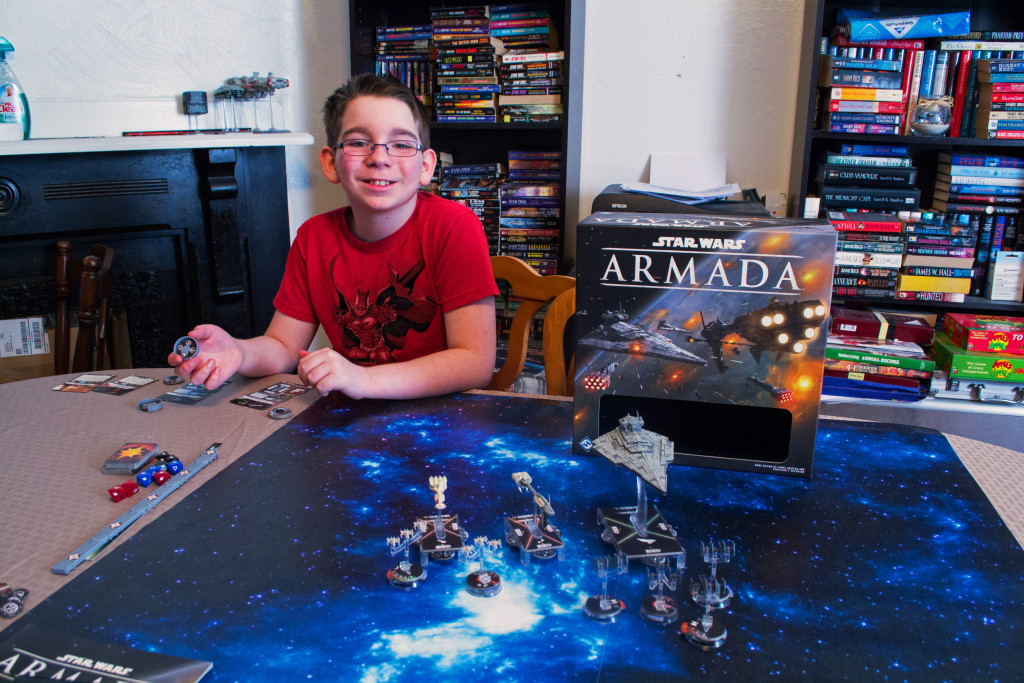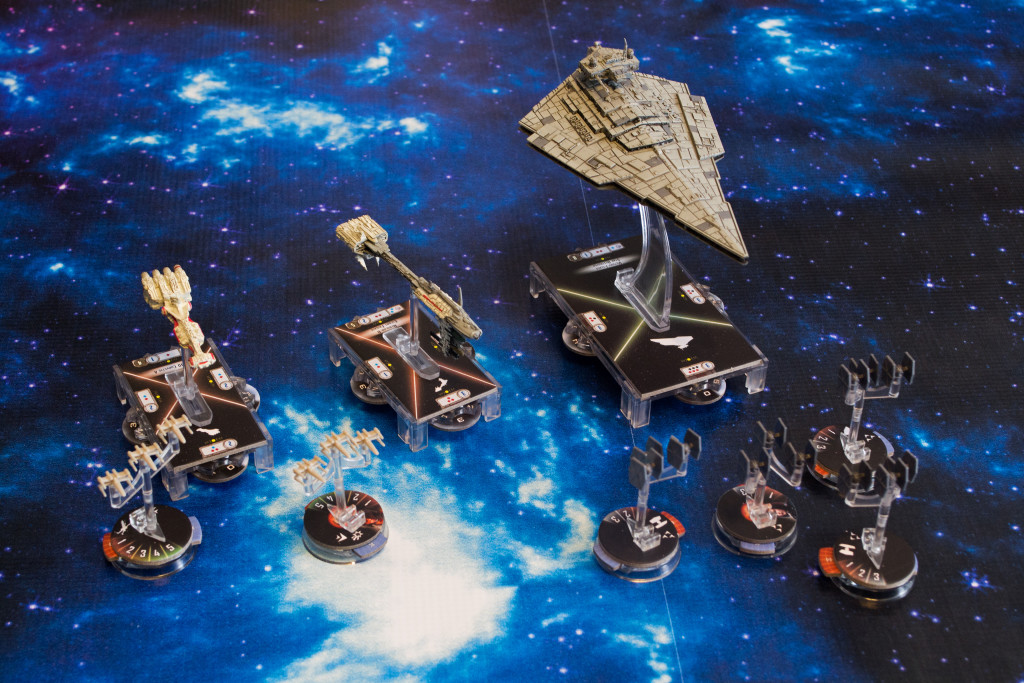It’s no secret that I consider the “Star Wars X-Wing Miniatures Game” to be one of the best tabletop games around. There’s only one problem…it’s designed with dogfights in mind, not capital ship battles. Sure, a few “huge” ships were introduced for the series, but the models were so large, unwieldy, and costly that it made using them a pain in the exhaust port. Then “Star Wars: Armada” came along…ooooh boy was I excited! It’s the complete opposite of “X-Wing”…that is, it focuses more on capital ship battles and less on dogfighting. Enough of the small talk though, let’s get right into this!
Components
The base game comes with a CR90 Corvette, a Nebulon-B Escort Frigate, Victory II-class Star Destroyer, 4 X-Wing Squadrons, and 6 TIE Fighter Squadrons, though you can purchase more via expansion packs to give yourself more options.
I was going to list all of the components here, but there are so many that your eyes would probably just glaze over. Check out pages 2 and 3 of the rulebook for the list (along with pictures of each).
Editor’s Note: The game mat featured in the pictures within this article was not included. I bought that separately. Learn how to make/buy your own via my “game mat” video, which can be found on my X-Wing YouTube series.
Setup & Gameplay
Like “X-Wing”, each ship has a fleet point cost. Players will agree on a fleet cost not exceeding 300 points. A 3×6 play area/mat is recommended, though you can get by with 3×3 if your table won’t support the former. The more ships you add, the larger the area you’ll want. Details about game setup and the restrictions that come with it can be found on page 20+ in the rulebook.
The game is played over six rounds with the goal being to eliminate the other player (or inflict more damage if that doesn’t happen). Each round has four phases:
1. Command Phase – Players assign command dials to each ship. On the first round, players will assign a number of dials equal to the ship’s command value, face down, in a stack. On future rounds, players only assign one dial, placing it at the bottom of their stack.
2. Ship Phase – Players take turns attacking with AND moving each of their ships. Starting with the player who has initiative, they’ll reveal their topmost command dial, attack, and then execute a maneuver. When revealing the command dial, players have the option of using it for full effect that round, or taking a token of that type for use in a future round (though a token isn’t as powerful). Ships can perform up to two attacks, though a hull zone can only fire once per round. There’s a lot more to say about combat (shields, tokens, hull damage, dice symbols, etc.), so I’ll opt to refer you to the rulebook (again) starting with page 8.
3. Squadron Phase – Players take turns attacking with OR moving their squadrons (not both). Starting with the player who has initiative, players will activate two squadrons at a time (in turn). Squadron movement and combat is simplified in that they don’t have firing arcs and can attack in any direction. Squadrons can attack capital ships, though MUST engage other enemy squadrons at range 1 if able.
4. Status Phase – Players ready all of their defense tokens and flip over the initiative token. The next highest round token is placed nearby and players begin a new round. The person with initiative retains initiative until the end of the game.
The game continues until one player eliminates the other or until six rounds expire. In the event of the latter, whoever scores more points (by counting up the enemy ships/upgrade cards they’ve destroyed) wins the game!
Editor’s Note: The above doesn’t cover all of the rules found in the manual, but should give you an idea as to how the game is played. For more information, you can check out the rulebook here:
The Review
I so wanted to write a lengthy review covering all of the game’s features and mechanics, but that would admittedly take days. There are times where I thought that the “Star Wars X-Wing Miniatures Game” was complicated…well, it’s got nothing on “Star Wars: Armada”! This game turned out to be much more in-depth and has a greater emphasis on planning ahead, what with the way manuever dials are stacked face-down ahead of time. Larger ships pack one heck of a punch, but require players to plan their commands sometimes three rounds ahead of the current one. This gives smaller ships a fighting chance as they have the ability to react more quickly to bad situations.
There are some similarities between “Armada” and “X-Wing”, though folks who are rigid and stubborn may have a hard time adapting. For example, I found it a little difficult to adjust to shooting first and THEN moving (the opposite of “X-Wing”). There’s also a separate speed dial to consider, requiring the use of a precious command (“navigate”) in order to speed up or slow down the ship in question. While I have some experience flying “Huge” ships in “X-Wing” and am familiar with the drifting that occurs during turns, I was admittedly surprised by the way some turns played out despite my well-thought-out plans.
Combat was also a bit more messy and took some getting used to. “Armada” features three differently colored dice, some of which are used only at particular ranges. What’s more, the capital ships each roll different dice depending on what hull zone they’re firing from. A Victory II shoots three red and three blue out of its front arc but only two red and one blue out the sides. At long-range, blue dice aren’t used at all. Instead of defense dice, players use defense tokens that refresh every round. Defenders can redirect damage, evade (force a re-roll or cancel an attack die), brace (half damage), and etc. Of course, not all ships have the same defensive abilities.
“Star Wars Armada” is hands-down a brilliant game, albeit a complicated one. The models are extremely well done and the art on the cards were both welcome and eye-catching. My only complaint was with the squadron bases…some didn’t fit together the right way and they were a real pain to assemble. The high price tag ($75-$100) may deter some from buying this game, though I personally don’t regret my purchase. I honestly can’t wait to bust out the Wave 1 ships I pre-ordered and give them a go when they arrive. Just be warned that this game is more demanding on your brain and your time than “X-Wing”, so be sure to reserve a couple of hours with each playthru and have the rulebook nearby. Speaking of which, I’ll be featuring expansions, games, and other goodies on my YouTube channel, so be sure to subscribe so that you can stay up to date with anything I happen to release in that video series!
Final Verdict: 9/10
—



I’ve played couple of games of SW Armada and I have to say I am a bit disappointed. On the one hand, it feels like being a commander of interstellar fleet and builds up tension as ships approach each other. However, on the other hand, it’s fiddly and it’s definitely a money drainer. In fact it brings the concept of draining money to a whole new level. Come on paying so much for so little?! FFG crossed the line with this one. You guys who are reading this review and this comment: think twice or thrice before jumping into this system as it will make your wallet cry. To make things worse it’s also extremely time consuming. A waste of life.
I won’t deny that it’s a money drainer, but then again the capital ships look fantastic. Had they looked like ships from “Star Trek: Attack Wing”, I would have been pretty upset. Any game featuring minis tend to be expensive all-around. I most certainly wouldn’t mind everything being cheaper and eventually “Armada” will come down in price once the initial launch hype wears off. “D&D Attack Wing” sold for $50-$60 at launch and now I’ve seen it go for $25-$30 on Amazon…good ol’ supply and demand. If money is an issue, I’d wait a little bit and buy it when it becomes cheaper. The expansions will no doubt add more flavor/content to the game, just as they did with “X-Wing”.
Are you planning on playing Imperial Assault?
I don’t own it.
A year later, I’m glad I got into Armada. I’ve always had a fascinating with the bigger ships, and many times I find running a game of Armada to be far faster than running a comparable game in X-Wing.
I don’t regret being heavily invested into X-Wing, but personally I called it done with getting any newer ships for it and instead am growing my Armada…. Uhm, armada. For me it’s what tickles my funny bone.